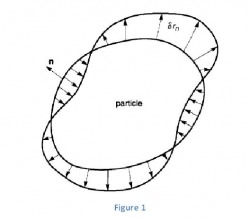Derivation of Weak Statement:
We know that all systems seek a preferred or lower energy state, G, which is a function of various parameters.
G=total free energy of system, V=Volume, g=Free energy per unit volume of atoms in bulk solid phase, τ- The free energy per unit length of a triple junction.
Kinetic Law
In order to reduce G, the volume summation over all phases, the surface integral over all surfaces, and the line integral over all triple junctions must change. So as this occurs, the free energy reduction per unit volume crossing the interface by P, is called the driving pressure. Subsequently, when the structure is near equilibrium, the normal velocity of the interface Vn, is proportional to the driving pressure and is known as the Kinetic Law.
Assumptions
Before we proceed, it is important to explain the assumptions made when numerically solving the system.
1) Atoms diffuse so fast in the vapor relative to the rate of interface reaction that the vapor has a spatially uniform chemical potential.
2) The amount of vapor is so large that compared to mass exchange due to evaporation and condensation that the vapor has constant chemical potential.
Weak Statement:
Figure 1 illustrates a single crystal particle immersed in a large mass of a vapor phase.
When interface tension is isotropic, P relates to the surface curvature by the Laplace-young relation. Herring [2] derived the expressions for P when the interface tension is anisotropic, and when interface forms facets given by:
By eliminating P from 1-3 and 1-2, we have the weak statement which is the basis for the finite element method.






